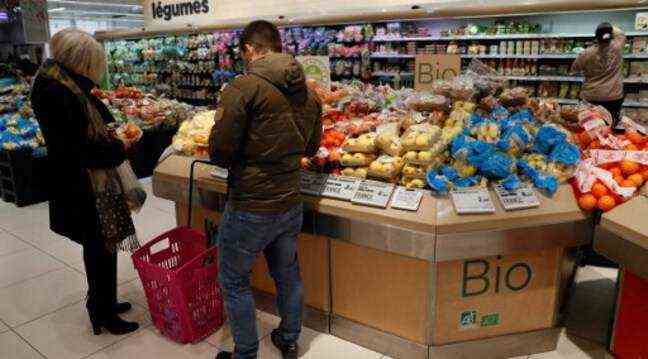Where is France on organic terms after such an atypical year 2020, due to the Covid-19 pandemic and periods of confinement? Organic Agency, a public body in charge of the development and promotion of French organic agriculture, publishes this Friday noon the quantified assessment of 2020. Which has what, on the whole, make Laure Verdeau smile.
The director of Agence Bio reviews the key figures for 2020 for 20 minutes.
13.2 billion euros, the size of the organic market
For the first time, the organic market has crossed the threshold of 13 billion euros in turnover in 2020. That is + 10.4% compared to 2019. Unsurprisingly, with the pandemic, purchases of organic catering products fell in 2020, by 21 points. They thus fell from a total amount of 640 million euros in 2019 to 505 million euros.
“But catering is only a small part of the organic cake,” says Laure Verdeau. Much smaller than that of household purchases for home consumption. “And this continued to grow in 2020. Of course, household food consumption increased overall in 2020, by 3.4%, but that of organic products jumped 12.2% compared to 2019 , to reach 12.67 billion euros. The sign that organic is becoming more and more anchored in the habits of the French and that it has especially taken advantage of the pandemic. “Many French people have turned to short circuits during confinement,” recalls Laure Verdeau. However, organic farmers are very present there, it is in their DNA. For example, 20% of French farmers sell directly. It is one in two in the bio. “
33.5%, the share of imports
This is the statistic that gives Laure Verdeau the most smile. These 33.5% represent the import rate of organic products in 2020 in France. “A stable figure compared to 2019 despite a strong increase in demand,” she insists. This import rate even drops to 20.9% if we remove tropical products, for which producing in France is complicated or even impossible, says Agence Bio.
Not nothing according to Laure Verdeau, while we have never been as concerned about food sovereignty as since the start of the Covid-19 pandemic. “Organic is establishing itself as a key player in this French sovereignty,” she insists. We create channels that fill the pantry of the French. 78% of organic vegetables consumed in France in 2020 were of French origin. “
53,255, the number of organic farms
In 2020, organic farming has passed the milestone of 50,000 organic farms. As of January 1, 2021, there were exactly 53,255, or 5,994 more than in 2019. “A progression similar to those recorded in past years,” continues the director of Agence Bio. Out of some 430,000 French farms (2016 figure from INSEE), 12% are now engaged in organic farming, a proportion which has tripled since 2010. They represent 18% of agricultural employment, their labor requirements being a little greater than conventional.
And it’s not just the farms that are making progress. Downstream companies (industrial processors, artisans, packers, etc.) do the same. 2,704 additional actors were registered in 2020, bringing their total number to 25,763. An increase of 12% compared to 2019. Enough to expand the product offer? The Bio Agency cites in any case, among those whose growth was the most dynamic in 2020, beers (+ 33% compared to 2019, already a good year) and frozen foods (+ 30%). “We have a virtuous circle, since the growing demand from the French for organic products and at all levels of the pantry is pushing downstream companies to develop,” Laure Verdeau says. However, they themselves source their raw materials in France, contributing a little more to boosting organic agricultural production. In total, the organic sector – farms as well as downstream companies – represents 200,000 jobs in France.
2.5 million, the number of hectares committed to organic
This represents 9.5% of the used agricultural area (UAA) French. These 2.5 million hectares include areas already certified organic. They have doubled in five years, going from 1 to 2 million hectares. In addition, there are areas under conversion, that is to say not yet certified but on which the organic specifications have already been applied. 592,592 hectares were thus in conversion in 2020, a relatively stable figure.
France has stronger and more regular organic growth than in the rest of Europe, boasts Agence Bio. Last year, the dynamic was particularly important in the field crops (cereals, oilseeds,
protein crops, pulses), with 29% more certified organic areas compared to 2019. “+ 64%, even, on oilseeds (flax, soybeans, and sunflowers)”, insists Laure Verdeau. It is not nothing whereas on some of these productions, France is today very dependent on the foreigner. This is particularly true for soybeans, imported mainly from Brazil, where this crop is a source of deforestation, to feed our farm animals.
Good progress for the vines as well, with a 22% growth in areas under organic cultivation. Fresh organic vegetables continue their momentum, with a + 16%. Conversely, fruits are showing an increase of 8%, and several breeding sectors are also suffering. That of dairy cows, for example, where the number of farms in conversion fell by 5% last year.
14, the number of departments that exceed 1,000 organic farmers
Another satisfaction: organic farming is gaining ground in the territories. Including those historically less committed, such as the Grand Est, Hauts-de-France, Center-Val-de-Loire, Bourgogne-Franche-Comté, Ile-de-France, Outremers. To measure this, Agence Bio looks in particular at the share of areas under conversion out of all those engaged in organic. In these regions that had lagged behind until then, it was around 30%, or even 38% for Ile-de-France.
The most involved regions – mainly around the Mediterranean rim – are making good progress. A third of the UAA is thus carried out organically in the PACA region, and a fifth (18%) in Occitania. The club of departments exceeding 1,000 organic farmers has also grown considerably. It went from 4 in 2018 to 14 in 2020.

